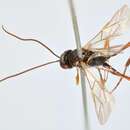en
names in breadcrumbs


Anomalon is a large genus of parasitoid wasps belonging to the family Ichneumonidae. This may be the only genus in the tribe Anomalonini, although Neogreeneia Viereck, 1912 is sometimes considered a valid genus of the tribe.[1][2]
These wasps are present worldwide, but most diverse in tropical regions.[3][4] Twenty species are recorded from Costa Rica. In the Africa and the Middle East, they are well represented in dry habitats, but in the Americas are most common in very wet rain forests. Recorded hosts include tenebrionid or elaterid beetle larvae and noctuid and tortricid moth larvae.[1]
"The species of Anomalon can easily be recognized from other Anomaloninae by the combination of the following morphological features:
Species within this genus include:[6][7]
Anomalon is a large genus of parasitoid wasps belonging to the family Ichneumonidae. This may be the only genus in the tribe Anomalonini, although Neogreeneia Viereck, 1912 is sometimes considered a valid genus of the tribe.
These wasps are present worldwide, but most diverse in tropical regions. Twenty species are recorded from Costa Rica. In the Africa and the Middle East, they are well represented in dry habitats, but in the Americas are most common in very wet rain forests. Recorded hosts include tenebrionid or elaterid beetle larvae and noctuid and tortricid moth larvae.